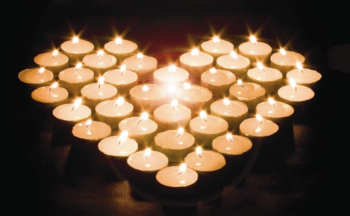While there are many books on meditation and contemplative prayer that outline various methods, I believe the essence of this prayer is not a method but simply resting in God’s presence: loving Him, and letting Him love you.
 My favorite of all mystical books is the anonymous Cloud of Unknowing, where the author describes contemplative prayer as simply reaching out to God with love. He says this in a hundred beautiful ways, without ever getting more specific. You know what love is—just do it. Abandon words, images, and ideas, and—as another of my favorite writers, Brother Lawrence, puts it—practice the presence of God. By all means engage your intellect in other forms of prayer as well. But in your time of contemplation, though you may begin with a phrase or image from your scripture reading that day, or with something else to which God has drawn your attention, after a while let that go and simply rest in His Spirit.
My favorite of all mystical books is the anonymous Cloud of Unknowing, where the author describes contemplative prayer as simply reaching out to God with love. He says this in a hundred beautiful ways, without ever getting more specific. You know what love is—just do it. Abandon words, images, and ideas, and—as another of my favorite writers, Brother Lawrence, puts it—practice the presence of God. By all means engage your intellect in other forms of prayer as well. But in your time of contemplation, though you may begin with a phrase or image from your scripture reading that day, or with something else to which God has drawn your attention, after a while let that go and simply rest in His Spirit.
Contemplative prayer is getting to know the Holy Spirit so that we can follow Him. Indeed contemplative prayer is worship of the Holy Spirit. I once had a theology professor who taught that one must not focus directly on the Holy Spirit, for His entire role is to be merely a “floodlight to illuminate Christ.” But this is not entirely true. In the Nicene Creed we confess that the Holy Spirit “together with the Father and the Son is to be worshipped and glorified.” Of the three members of the Trinity, the Spirit is the most mysterious. The Son we may easily picture, walking by the shores of the Sea of Galilee, or hanging on the cross. And it is possible to form a concept of the Father—as creator, tender parent, and so on. But the Spirit is unimaginable; images such as fire or the dove are mere symbols. He is the one who most of all leads us into the pure mystery of God.
So get to know the Holy Spirit by spending time with Him without any other agenda. Love and worship are characterized by not requiring anything of God—not guidance, wisdom, answers, or comfort. We simply bask in God Himself—not His creation, not His manifestations, not even His qualities or attributes, but just Him. As a writer, I’m very glad if you like my books. But they’re not me. God’s name, His personal name, is I Am—nothing else, just pure Being. I think Jesus must have been the loneliest person who ever lived. Everyone wanted a piece of Him, not the whole person, not the man Himself. Be a friend of Jesus. Be like Mary, Martha’s sister, who wanted—and chose—nothing more than to be with Him.
Contemplative prayer is pure delight in the mere being of The Other. Pure feeling, unattached to any reason or thing or outcome. There’s nothing else like this. St Teresa of Avila wrote that one minute of this kind of being with God is worth any amount of any other sort of prayer. I can testify to the truth of this. You may wonder: What is the use of contemplative prayer if there’s no content to it? No words, images, ideas, nothing to take away? All I can say is: Try it—try feeling God—and you will be amazed at how beautifully it prepares you for everything you need to do in life. Pray like this, and you won’t need to worry about what God’s will is; you’ll just find yourself doing it. You’ll sense Him saying to you, “Do whatever your hand finds to do, for I am with you” (1 Sam 10:7).
[End of Part 3. To be continued next week. Sign up here to receive weekly installments in your email box.]
